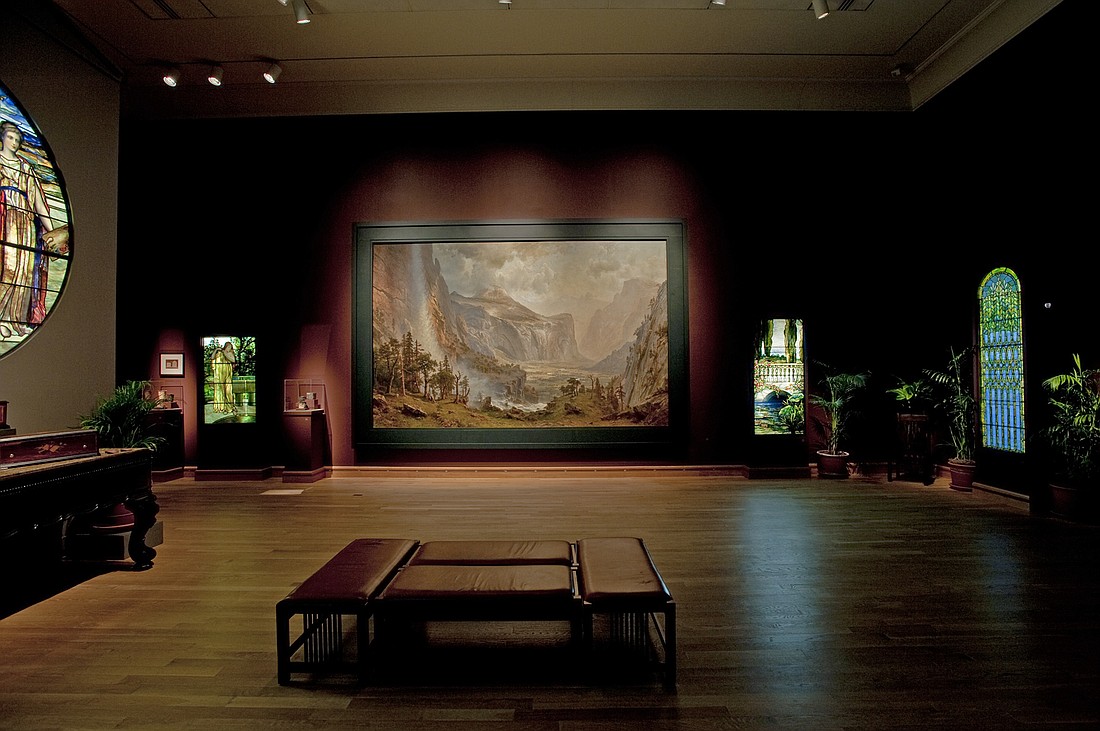- April 19, 2024
-
-
Loading

Loading

It’s hard to miss when you’re standing in front of it, yet it’s only here for a brief window of time. It measures 9-and-a-half feet by 15 feet. It’s a piece of art history, and it’s hanging in the Charles Hosmer Morse Museum of American Art. The largest existing painting by famed artist Albert Bierstadt, titled “The Domes of the Yosemite,” will be hanging inside the local museum until July 8, when it will return to its home at the St. Johnsbury Athenaeum in Vermont.
Winter Park has become the temporary destination for the painting following a nearly four-month restoration process at the ArtCare Conservation Studio in Miami — an undertaking that was financially supported by the Elizabeth Morse Genius Foundation in Winter Park. The perimeter of the canvas was repaired, distortions were flattened, and surface grime and old varnish were removed.
The move to Miami in October was the first time the painting had left its Vermont home since it was installed in 1873.
“It is a privilege to be able to present this masterpiece of a painting in Winter Park for our visitors,” museum director of public affairs and publications Catherine Hinman said. “It has not been shown outside of St. Johnsbury for 145 years, and it will likely not travel again in our lifetime.”
The painting was a commissioned work done by Bierstadt in 1867. Its creation was inspired by the West’s raw and rugged beauty, based on sketches and photographs Bierstadt made while traveling through California’s Yosemite Valley by stagecoach and horseback.
For many Americans, the painting that would stem from these images would be their first look at the wild soaring vistas of the western territories.
“Bierstadt was one of the most celebrated artists of his time, and this painting of Yosemite, his largest canvas at that time, became famous through published reviews,” Hinman said. “When it went on a three-city tour in 1867, it served as an introduction to the beauty of the American West to the curious residents of the East. It’s not only a work of art, it’s a historical document.”
The painting originally belonged to the American financier who commissioned the painting for $25,000: LeGrand Lockwood, who planned to display the painting in his home in Norwalk, Connecticut.
After Lockwood died, the painting was auctioned and purchased by Horace Fairbanks in St. Johnsbury. Fairbanks sought to give back to his community and founded the St. Johnsbury Athenaeum in 1871 to house a collection of books and artwork. He had “The Domes of the Yosemite” placed there roughly two years later.
There is also a Winter Park connection within the history of the storied painting. Charles Hosmer Morse, the industrialist and philanthropist for whom the Morse Museum is named, was born and raised in St. Johnsbury. Horace Fairbanks’ brother, Franklin, was also a friend of Morse and an early investor in Winter Park real estate. Fairbanks Avenue is even named after Franklin.
“They all knew each other,” Hinman said. “Horace Fairbanks, who bought this painting, was a little older than Charles and Franklin, but they had this sense that a community should have access to art, education and books.”
Bierstadt’s painting catches the eyes of visitors as soon as the step into the room at the Morse Museum. That was the case for visitor Margaret Donnelly, who had heard murmurs about the painting.
“It’s just impressive; you can almost feel the water moving,” Donnelly said.
Carmen Melian had come to the Morse Museum with her cousin Donnelly to see the comprehensive collection of works by Louis Comfort Tiffany, but had heard that they could not miss the Bierstadt.
“A lot of these artists made their living on traveling paintings at the time, because there were no movies,” Melian said. “They’re sometimes better than the real thing, because it’s a composite. … You just go straight in. You sort of meander into the painting. The whole thing is very uplifting.”
Hinman said one thing is for certain: You have to see “The Domes of the Yosemite” to believe it.
“Now the painting has been returned to its original glory by the expert conservation team in Miami, and visitors to the Morse are seeing the painting just as it was seen in 1867,” Hinman said. “It is luminous and seductive. You have to see it to truly experience its impact. Pictures can’t convey its emotion and drama.”